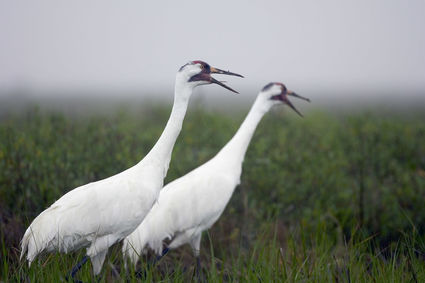Record numbers of whooping cranes coming
Last updated 10/25/2010 at Noon
Staff Report
TheRecrodLive
AUSTIN – Things are looking up for the endangered whooping crane. The
bird made news two years ago when a record number of crane deaths were
reported during drought conditions on the Texas coast. But according to
state and federal biologists, flock numbers have rebounded, and a new
record high number of cranes should start arriving on the Texas coast
later this month.
Texas’ winter flock of whooping cranes (the birds summer and nest in
northwestern Canada in Wood Buffalo National Park) represents the last
remaining “natural” flock of whooping cranes in the wild, and, according
to Lee Ann Linam, Texas Parks and Wildlife Department biologist, Texas
plays an important role in the species’ future recovery.
Whooping cranes winter in wetlands along a section of the Texas coast
ranging from approximately Seadrift to Rockport, including at the
Aransas National Wildlife Refuge. Linam notes that public and private
landowners within the region are collaborating in habitat management
efforts for whooping cranes, but potential threats still exist, such as
oil spills, coastal development, and reduced freshwater inflows.
According to U.S. Fish and Wildlife Service Biologist Tom Stehn, the
Aransas-Wood Buffalo population of whooping cranes rebounded to 264 in
the winter of 2009-10, back from 247 at the end of the 2008-09 winter.
With 46 chicks fledging from a record 74 nests in August 2010 the flock
size should reach record levels this fall — expected to be somewhere
around 290. Once numbering only 21 birds on earth, the previous
population high was 270 in the fall of 2009.
“Under good conditions, Texas’ coastal wetlands provide a variety and
abundance of food and fresh water that normally lead to excellent
survival of whoopers over the winter,” Linam said. “Such excellent
winter survival has greatly aided the species’ amazing comeback.”
Texas also plays an important role in conserving whooping cranes as
they migrate through the state. The cranes usually pass through a
migration corridor that extends from the Texas
Panhandle eastward to
Dallas-Fort Worth and southward to the central coast wintering grounds.
Their flight path would take them over cities such as Wichita Falls,
Fort Worth, Waco, Austin, and Victoria. The majority of the cranes pass
south through Texas from late October through the end of November.
Whooping cranes are the tallest birds in North America, standing over
four feet tall. They are solid white in color except for black
wing-tips visible only in flight. They fly with necks and legs
outstretched. During migration they often pause overnight to use
wetlands for roosting and agricultural fields for feeding, but seldom
remain more than one night. They nearly always migrate in small groups
of less than four-to-five birds, but they may be seen roosting and
feeding with large flocks of smaller sandhill cranes. Hunters are
advised to learn to tell the difference between whooping cranes and
sandhill cranes, a popular game bird.
Whooping cranes are protected by federal and state endangered species
laws, and Texans can help safeguard this national treasure by helping
to prevent harm or harassment to whooping cranes. Anyone sighting a
whooping crane is asked to report it to Texas Parks and Wildlife
Department at (800) 792-1112, extension 4644 or (512) 847-9480.
Sightings can also be reported via e-mail at [email protected].








Reader Comments(0)